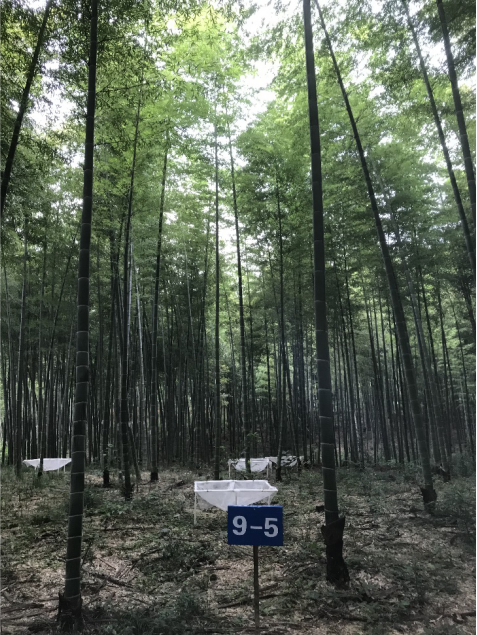 PDF(2003 KB)
PDF(2003 KB)


带状采伐对毛竹林土壤细菌群落结构及多样性的影响
王树梅, 王波, 范少辉, 肖箫, 夏雯, 官凤英
南京林业大学学报(自然科学版) ›› 2021, Vol. 45 ›› Issue (2) : 60-68.
 PDF(2003 KB)
PDF(2003 KB)
 PDF(2003 KB)
PDF(2003 KB)
带状采伐对毛竹林土壤细菌群落结构及多样性的影响
Influence of strip cutting management on soil bacterial community structure and diversity in Phyllostachys edulis stands

【目的】研究带状采伐后毛竹(Phyllostachys edulis)林土壤细菌群落结构及多样性的变化,认识带状采伐对毛竹林土壤生态系统的影响,为利用带状采伐实现毛竹林规模化经营提供指导。【方法】对毛竹林进行不同宽度(3、9、15 m)的带状采伐,25 d后采集样地内土壤样品,采用Illumina MiSeq 高通量测序技术分析土壤细菌特定基因片段V3-V4区域,鉴定菌种类群,预测细菌功能,并结合7种土壤养分指标(有机质、全氮、全磷、全钾、碱解氮、有效磷、速效钾)的测定结果,探讨带状采伐对毛竹林地土壤细菌群落及土壤养分的影响。【结果】随着采伐宽度的增加,土壤有效磷、全钾、速效钾含量降低,土壤有机质、全氮、碱解氮含量先增后降。适当采伐可以提高土壤肥力,但采伐宽度超过一定限度后,土壤肥力降低,速效养分含量减少。不同带状采伐对毛竹林土壤中细菌类群的丰度、多样性、均匀度的影响各不相同;3 m采伐宽度的毛竹林地内土壤细菌群落丰富度最高,且物种分布最均匀,随着采伐宽度的增大,其毛竹林地内的细菌群落丰富度和物种均匀度均降低,当采伐宽度超过9 m时,群落间的物种组成变化差异减小。带状采伐后变形菌门(Proteobacteria)相对丰度增多,酸杆菌门(Acidobacteria)、绿湾菌门(Chloroflexi)相对丰度减少,这3种菌门同放线菌门(Actinobacteria)一起占据着毛竹林带状采伐土壤细菌群落种的主要地位,对土壤中碳(C)、氮(N)元素固定及其他养分的转化分解发挥着重要的作用。带状采伐后土壤细菌群落代谢通路中最重要的是碳水化合物代谢和氨基酸代谢,说明带状采伐后土壤细菌的优势功能主要集中在C、N两种元素的固定和转化。【结论】毛竹林带状采伐对土壤细菌群落结构及多样性产生显著影响,3 m宽度的带状采伐能够增加细菌类群的丰度、多样性、均匀度以及土壤养分含量,当采伐宽度增大,上述各项指标降低;综合分析表明带状采伐后土壤微生物类群主要参与C、N元素的固定和转化的相关功能通路。
【Objective】In order to provide scientific guidance for understanding the management of bamboo (Phyllostachys edulis) forests stands and restoration of soil ecosystems, the impact of strip cutting on soil bacterial community structure and diversity was studied. 【Method】Soil samples were collected from P. edulis stands of different widths (3, 9 and 15 m) after 25 d at Yixing, Jiangsu Province. V3-V4 regions were sequenced using the Illumina MiSeq High Throughput Sequencing to identify soil bacteria and predict functional groups. Soil organic matter, total N, total P, total K, available N, available P and available K were analyzed using standard methods.【Result】With the increase in cutting width, the contents of soil available P, total K, and available K decreased, while the contents of soil organic matter, and total and available N initially increased and then decreased. The selection of the appropriate cutting width could improve soil fertility, but when the cutting width exceeded a certain limit, the soil fertility and the content of available nutrients decreased. Strip cutting management had an impact on the soil bacterial abundance, diversity and evenness. At a cutting width of 3 m, the soil bacterial community was richer, and species distribution was more uniform than others. With the increase in the cutting width, the bacterial community richness and uniformity in the P. edulis forest decreased. When the cutting width exceeded a certain level, the difference in species composition between communities decreased. Strip cutting increased the diversity of Proteobacteria and decreased that of Acidobacteria and Chloroflexi. Proteobacteria, Actinobacteria, Acidobacteria and chloroflexi belong to the same functional group in the stripped soil of the bamboo forest, stimulating carbon and nitrogen fixation and the transformation and decomposition of other nutrients. The main metabolic pathways after strip cutting were carbohydrate and amino acid production.【Conclusion】Comprehensive analyses showed that strip cutting of P. edulis forests had a significant influence on the soil bacterial community structure and diversity. The shorter width (3 m) strip cutting could increase the abundance and diversity of soil bacteria and nutrient content. However, with the increase in strip-cutting width, the various indicators decreased. After strip cutting, soil microbial groups mainly acted on the fixation, decomposition, and transformation of C and N.

毛竹 / 带状采伐 / 土壤细菌 / 细菌多样性 / 细菌群落丰富度 / 功能预测
Phyllostachys edulis / strip cutting / soil bacteria / bacterial biodiversity / bacterial community richness / function prediction
| [1] |
国家林业与草原局. 中国森林资源报告 [M]. 北京: 中国林业出版社, 2019.
National Forestry and Grassland Administration. China forest resources report [M]. Beijing: China Forestry Publishing House, 2019.
|
| [2] |
|
| [3] |
范少辉, 刘广路, 苏文会, 等. 竹林培育研究进展[J]. 林业科学研究, 2018,31(1):137-144.
|
| [4] |
苏文会, 曾宪礼, 范少辉, 等. 带状采伐对毛竹非结构性碳与生物量分配的影响[J]. 生态学杂志, 2019,38(10):2934-2940.
|
| [5] |
曾宪礼, 苏文会, 范少辉, 等. 带状采伐毛竹林恢复的质量特征研究[J]. 西北植物学报, 2019,39(5):917-924.
|
| [6] |
曾宪礼, 苏文会, 范少辉, 等. 带状采伐毛竹林土壤质量评价[J]. 生态学杂志, 2019,38(10):3015-3023.
|
| [7] |
|
| [8] |
张明锦, 陈良华, 张健, 等. 马尾松人工林林窗内凋落叶微生物生物量碳和氮的动态变化[J]. 应用生态学报, 2016,27(3):672-680.
|
| [9] |
|
| [10] |
|
| [11] |
|
| [12] |
|
| [13] |
|
| [14] |
|
| [15] |
|
| [16] |
张明锦, 张健, 纪托未, 等. 林窗对凋落物分解过程中细菌群落结构和多样性的影响[J]. 生态环境学报, 2015,24(8):1287-1294.
|
| [17] |
张晓, 刘世荣, 黄永涛, 等. 辽东栎林演替过程中的土壤细菌群落结构和多样性变化[J]. 林业科学, 2019,55(10):193-202.
|
| [18] |
鲁如坤. 土壤农业化学分析方法 [M]. 北京: 中国农业科技出版社, 2002.
|
| [19] |
管云云, 费菲, 关庆伟, 等. 林窗生态学研究进展[J]. 林业科学, 2016,52(4):91-99.
|
| [20] |
|
| [21] |
张小鹏, 王得祥, 常明捷, 等. 林窗干扰对森林更新及其微环境影响的研究[J]. 西南林业大学学报, 2016,36(6):170-177.
|
| [22] |
韩文娟, 何景峰, 张文辉, 等. 黄龙山林区油松人工林林窗对幼苗根系生长及土壤理化性质的影响[J]. 林业科学, 2013,49(11):16-23.
|
| [23] |
刘聪, 朱教君, 吴祥云, 等. 辽东山区次生林不同大小林窗土壤养分特征[J]. 东北林业大学学报, 2011,39(1):79-81.
|
| [24] |
欧江, 刘洋, 张捷, 等. 长江上游马尾松人工林土壤铵态氮和硝态氮对采伐林窗的初期响应[J]. 应用与环境生物学报, 2015,21(1):147-154.
|
| [25] |
|
| [26] |
贺纪正, 王军涛. 土壤微生物群落构建理论与时空演变特征[J]. 生态学报, 2015, 35(20):1-2, 6575-6583.
|
| [27] |
丁新景, 敬如岩, 黄雅丽, 等. 基于高通量测序的4种不同树种人工林根际土壤细菌结构及多样性[J]. 林业科学, 2018,54(1):81-89.
|
| [28] |
王安宁, 黄秋娴, 李晓刚, 等. 冀北山区不同植被恢复类型根际土壤细菌群落结构及多样性[J]. 林业科学, 2019,55(9):130-141.
|
| [29] |
|
| [30] |
周本智, 傅懋毅. 竹林地下鞭根系统研究进展[J]. 林业科学研究, 2004,17(4):533-540.
|
| [31] |
翟婉璐, 钟哲科, 高贵宾, 等. 覆盖经营对雷竹林土壤细菌群落结构演变及多样性的影响[J]. 林业科学, 2017,53(9):133-142.
|
| [32] |
|
| [33] |
|
| [34] |
|
| [35] |
|
/
| 〈 |
|
〉 |